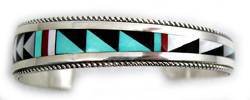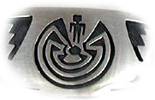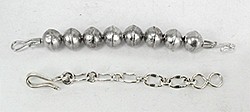  Not
All Silver Is Equal Not
All Silver Is Equal
© 2007 Horsekeeping LLC ©
Copyright Information Pure
silver is generally too soft for jewelry making, so
it is combined (alloyed) with other metals. Sterling
Silver: Sterling silver and is stamped as "sterling" or ".925"
which indicates that it is 92.5 percent pure silver. By law sterling silver must
contain no less than 92.5% fine silver with the remainder being any other metal.
The other 7.5 percent of the material is comprised of alloys, usually copper (which
is what causes sterling silver to tarnish). Traditionally
precious metals and jewelry weights are listed in grams or Troy ounces. There
are approximately 31.1 grams in one Troy ounce. 
Mexican
Silver: Mexican Silver (NOT Alpaca, see below) is usually
95% Silver and 5% Copper. After World War II, for jewelry and objects made in
Taxco, Mexico, the Mexican government issued an assay mark guaranteeing the purity
to be .925 or higher. This mark is referred to as the "spread eagle" mark. The
original mark did look like an eagle, but with modifications over the years, the
mark was simplified. The number inside the mark is a workshop or city designation.
In 1979, this mark was abandoned in favor of a series of registry letters and
numbers assigned to individuals and workshops. Mexican silver is softer than sterling
silver so bends more easily . . . which can be either a good or a bad thing. Coin
Silver: When used in association with vintage Native American jewelry, this
refers to the alloy that resulted when pre-1965 US silver coins were melted down
to reuse in jewelry making. Coin silver made from US coins has less silver than
sterling silver (90% compared to 92.5% in sterling silver) but that doesn’t necessarily
make coin silver jewelry less desirable. In fact, because coin silver jewelry
is usually older and hand hammered, it might be more valuable than if it were
made of sterling silver. Vintage Mexican coins often had a silver content above
that of US coins, therefore was softer and easier to hand hammer and preferred
by some old-time silversmiths. Some Mexican coin silver jewelry will test as high
as sterling silver. Alpaca is
a term that is often stamped on Mexican (and German) pieces and sometimes it is
called Alpaca Silver but it contains no silver at all. Alpaca
is usually composed of 65% copper, 18% nickel and 17% zinc. It is similar to German
Silver and Nickel Silver (see below). Argentium®
Sterling Silver: A registered and patented alloy of sterling silver, copper
and a small amount of the element germanium, developed in 1984. This alloy has
excellent tarnish resistance and requires minimal maintainance to remain looking
like new. This phenomenon is a result of a transparant layer of germanium oxide
thats forms on the surface of the metal and slows the formation of silver sulphide,
or tarnish. Tarnish is formed when sulfur reacts with the copper in sterling silver
to form silver sulphide. This sulfur can come from the air, perfume, deodorant
or skin, among other sources. An occasional wash and rinse and/or wipe with a
soft cotton cloth is all that's needed to keep an object made from Argentium Sterling
Silver in pristine condition. German
Silver: It is not actually silver at all! Also called nickel silver, this
popular alloy contains copper, zinc and nickel, but has no silver in it. Also
sold under manufacturers' trade names, this material is very hard and generally
must be machined. Many people are allergic to nickel and get what is called "nickel
itch" when contacting nickel silver. Nickel
Silver: See German Silver above. Silver
Overlay : This can have several meanings. When used in high-end tack accents,
belt buckles and so on, silver overlay is made by mechanically bonding  a
layer of sterling silver over a thicker base metal, usually nickel. This creates
a metal with the qualities of sterling at a lower price. Sterling overlay should
be thick enough to allow the silversmith to make his engraving cuts in the sterling
layer without cutting through to the base metal below. But in Native American
jewelry, silver overlay refers to 100% Sterling Silver, both layers are sterling
silver. The top layer is cut out with a jeweler's saw and placed on a solid sterling
silver base. The Hopi Indians excel at Sterling Silver overlay. a
layer of sterling silver over a thicker base metal, usually nickel. This creates
a metal with the qualities of sterling at a lower price. Sterling overlay should
be thick enough to allow the silversmith to make his engraving cuts in the sterling
layer without cutting through to the base metal below. But in Native American
jewelry, silver overlay refers to 100% Sterling Silver, both layers are sterling
silver. The top layer is cut out with a jeweler's saw and placed on a solid sterling
silver base. The Hopi Indians excel at Sterling Silver overlay. Silver
plate: Silver plating is the least expensive method of utilizing silver in
decorative work. To silver plate, a base metal is electrostatically charged, so
that a very thin layer of silver adheres to the base. The silver is usually applied
as a liquid and is at approximately 7 millionths of an inch thick. Silver plate
cannot be hand engraved, but it's often applied over design cuts made in the base
metal. 
Native
American Silversmithing Styles Navajo
- The Navajo were the first silversmiths. They commonly design jewelry around
a stone's natural shape. When they do inlay, it is bolder than Zuni inlay and
usually has silver between the inlaid stone pieces (called "channel inlay"). Zuni
- The Zuni are known as stonesmiths that cut stones to fit into a precise geometric
pattern or design. They tend to use four traditional colors:  Blue
- turquoise Blue
- turquoise
Red - Coral
Black - Jet or Onyx
White
- Opal or Mother of Pearl
Zuni
inlay tends to be more complex than Navajo, with more cuts and patterns. They
usually don't use silver between the inlaid pieces but produce "stone on
stone" inlays. The Zuni also produce meticulous Needlepoint (narrow
stones pointed on both ends) and Petit Point (any other small cut stone
shape such as oval, teardrop etc.) pieces, often in clusters. Most snake
designs are done by the Zuni.  Hopi
- The Hopi are known as master silversmiths who design overlay pieces mostly of
solid silver with a cutout design on top of the main piece. The two pieces are
"sweated" together, that is heated so that they become one. The background
piece is usually oxidized (darkened) and etched (texturized) with hashmarks. Two
characteristics of Hopi work are overlay and minimal use of stones. Hopi
- The Hopi are known as master silversmiths who design overlay pieces mostly of
solid silver with a cutout design on top of the main piece. The two pieces are
"sweated" together, that is heated so that they become one. The background
piece is usually oxidized (darkened) and etched (texturized) with hashmarks. Two
characteristics of Hopi work are overlay and minimal use of stones.

Silver
Manufacturing Methods Handmade:
As the name implies, metal manipulation is done by hand, from cutting to polishing
and engraving. Labor always increases cost, so this is the most expensive manufacturing
method and also the most desired by consumers. Handmade accessories will typically
have slight yet charming variations in shape and finish. Benchmade:
This is a term that refers to an item that is partially handmade and partially
machine-made. For example, some silver Navajo beads have machine cut pieces that
then are soldered and hand strung by a Navajo Indian craftsman. These are considered
benchmade. Machine-made: Metal
is machine-manipulated for cost savings and uniformity. Industrial presses cookie-cut
shapes, which are then embossed by hydraulic machines. For modestly priced goods,
machine-made pieces are often stamped from nickel or a proprietary alloy, then
plated with sterling silver or other metal for a shiny finish. Hallmark:
 Most
modern Indian jewelry is stamped "Sterling" and is signed or stamped
with a hallmark by the artist. However a lack of hallmarks, initials, or signatures
doesn't mean it is not authentic. In the past, most reservation-made Indian jewelry
was not signed and had no hallmark. Most
modern Indian jewelry is stamped "Sterling" and is signed or stamped
with a hallmark by the artist. However a lack of hallmarks, initials, or signatures
doesn't mean it is not authentic. In the past, most reservation-made Indian jewelry
was not signed and had no hallmark. Read
about Silver Care and Cleaning See
our selection of Authentic Native American Jewelry | 
